〖同步教学计划〗2018-2019学年第一学期pep六年级英语教学计划
pep小学六年级英语上册教学计划

PEP小学六年级英语上册教学计划随着教育的不断发展,英语教学在我国小学教育中占据越来越重要的地位。
为了让孩子们更好地掌握英语知识,提高英语素养,我们特制定PEP小学六年级英语上册教学计划。
本计划以学生为主体,注重培养学生的听、说、读、写能力,全面提高学生的英语水平。
一、教学目标1.培养学生的英语学习兴趣,激发学生的学习潜能。
2.使学生掌握英语基础知识,提高学生的英语素养。
3.培养学生具备一定的听、说、读、写能力,为升入初中做好过渡。
二、教学内容1.教材:使用人民教育出版社出版的《PEP小学英语》六年级上册教材。
2.课程内容:包括Units1-12的课文内容、单词、语法、功能句型及练习。
三、教学安排1.课时:每周三节课,共计36课时。
2.教学时间:2022年9月-2023年1月。
四、教学方法1.情境教学法:通过设定各种真实的生活情境,让学生在交流中学习英语。
2.任务型教学法:以完成具体任务为目标,培养学生实际运用英语的能力。
3.游戏教学法:运用趣味性游戏,激发学生的学习兴趣。
4.分组合作学习:鼓励学生互相合作,提高团队意识。
五、教学评价1.过程性评价:关注学生在课堂上的表现,及时给予鼓励和指导。
2.单元测试:每学完一个单元,进行一次测试,了解学生掌握情况。
3.期中、期末考试:进行期中、期末考试,全面评估学生学习成绩。
六、教学措施1.强化口语训练:要求学生在课堂上大胆开口,提高口语表达能力。
2.个性化辅导:针对学生不同需求,给予个性化辅导,提高学生英语水平。
3.家校合作:积极与家长沟通,共同关注学生的英语学习。
4.举办丰富多彩的活动:组织英语角、英语剧社等活动,激发学生的学习兴趣。
七、教学展望通过本教学计划的实施,我们期待学生能在小学六年级结束时,掌握英语基础知识,具备一定的听、说、读、写能力,为今后的英语学习奠定坚实基础。
同时,我们也将不断调整教学策略,努力提高教学质量,为学生的全面发展贡献力量。
2019学年第一学期小学英语六年级上册教学计划
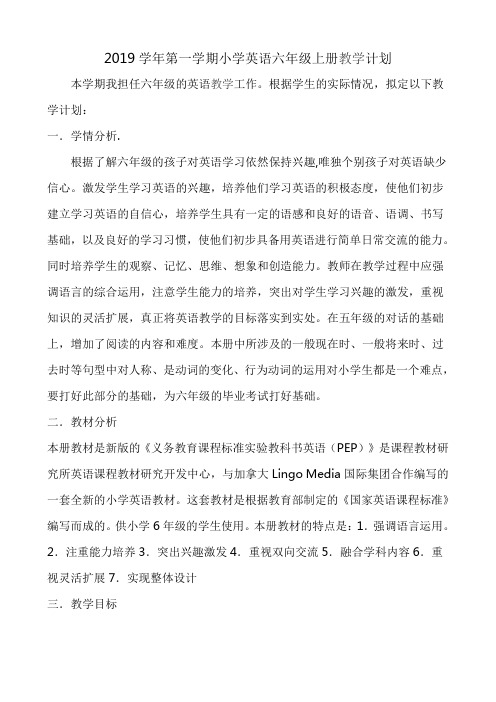
2019学年第一学期小学英语六年级上册教学计划本学期我担任六年级的英语教学工作。
根据学生的实际情况,拟定以下教学计划:一.学情分析.根据了解六年级的孩子对英语学习依然保持兴趣,唯独个别孩子对英语缺少信心。
激发学生学习英语的兴趣,培养他们学习英语的积极态度,使他们初步建立学习英语的自信心,培养学生具有一定的语感和良好的语音、语调、书写基础,以及良好的学习习惯,使他们初步具备用英语进行简单日常交流的能力。
同时培养学生的观察、记忆、思维、想象和创造能力。
教师在教学过程中应强调语言的综合运用,注意学生能力的培养,突出对学生学习兴趣的激发,重视知识的灵活扩展,真正将英语教学的目标落实到实处。
在五年级的对话的基础上,增加了阅读的内容和难度。
本册中所涉及的一般现在时、一般将来时、过去时等句型中对人称、是动词的变化、行为动词的运用对小学生都是一个难点,要打好此部分的基础,为六年级的毕业考试打好基础。
二.教材分析本册教材是新版的《义务教育课程标准实验教科书英语(PEP)》是课程教材研究所英语课程教材研究开发中心,与加拿大Lingo Media国际集团合作编写的一套全新的小学英语教材。
这套教材是根据教育部制定的《国家英语课程标准》编写而成的。
供小学6年级的学生使用。
本册教材的特点是:1.强调语言运用。
2.注重能力培养3.突出兴趣激发4.重视双向交流5.融合学科内容6.重视灵活扩展7.实现整体设计三.教学目标1.能听、说、读、写67个单词或短语以及35个句子。
(包括建筑,方位,交通工具,工作职位,周末和假期活动、旅行、等几个话题)。
要求能在真实语境中正确运用并能读懂简短语篇。
2.能完成1个手工制作。
3.能听懂、会唱6首歌曲。
4.能听懂、会吟唱6首歌谣。
5.能完成4个自我评价活动。
6.能理解6个幽默小故事。
7.能了解6项简单的中西方文化知识。
四.教材重难点能按四会、三会的要求掌握所学单词。
能按四会要求掌握所学句型。
能使用日常交际用语,活用四会句型,进行简单的交流,做到大胆开口,发音正确。
2018-2019第一学期六年级PEP英语教学设计
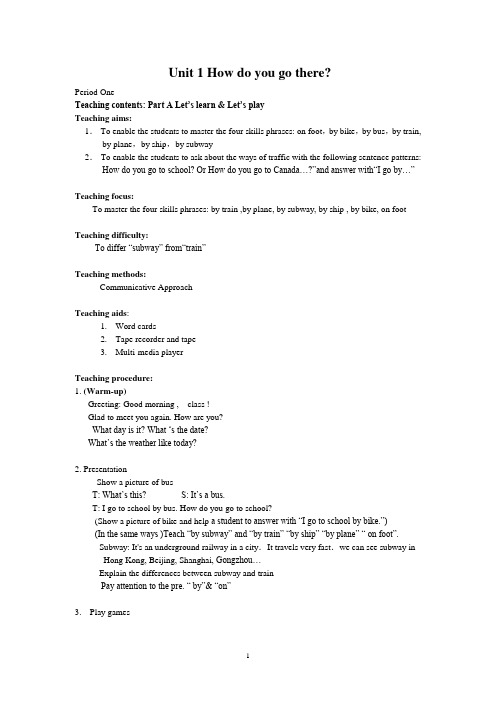
Unit 1 How do you go there?Period OneTeaching contents: Part A Let’s learn & Let’s playTeaching aims:1.To enable the students to master the four skills phrases: on foot,by bike,by bus,by train, by plane,by ship,by subway2.To enable the students to ask about the ways of traffic with the following sentence patterns: How do you go to school? Or How do you go to Canada…?‖and answer with―I go by…‖Teaching focus:To master the four skills phrases: by train ,by plane, by subway, by ship , by bike, on footTeaching difficulty:To differ ―subway‖ from―train‖Teaching methods:Communicative ApproachTeaching aids:1.Word cards2.Tape recorder and tape3.Multi-media playerTeaching procedure:1. (Warm-up)Greeting: Good morning , class !Glad to meet you again. How are you?What day is it? What ‗s the date?What‘s the weather like today?2. PresentationShow a picture of busT: What‘s this? S: It‘s a bus.T: I go to school by bus. How do you go to school?(Show a picture of bike and help a student to answer with ―I go to school by bike.‖)(In the same ways )Teach ―by subway‖ and ―by train‖ ―by ship‖ ―by plane‖ ― on foot‖.Subway: It's an underground railway in a city.It travels very fast.we can see subway in Hong Kong, Beijing, Shanghai, Gongzhou…Explain the differences between subway and trainPay attention to the pre. ― by‖& ―on‖3.Play gamesAsk one S to the front and stick the word cards next to the phrases written on the Bb when T read the new phrases quickly and the other Ss put up their cards. The one who reflect fastest and correctly is the winner.4.Listen to the tape of Part A Let‘s learn and follow it.Pay attention to the tone and pronunciation5.Practice: Let‘s playT Offer many places (the USA. England Australia Hong Kong Shanghai Guangzhou the moon…)and traffic ways (by car/ taxi/ bus… on foot)Ss practice with above places and ways in pairs:A: How do you go to school?B: I go to school on foot.Encourage the Ss to make up as many sentences as they can.6.Spelling competitionDivide the class into tow groups. Show the pictures of traffic tools and ask Ss to spell the phrases. The first one who puts up hand gets the chance to spell. The group spell out more phrases are the winners.HomeworkCopy the new words and phrasesFinish Page1 of the ABBb design:Unit One How do you go thereHow do you go to school/ Canada?I go to school on foot/ by subway/ bus/ train/ taxi…Teaching reflection:Unit1 How do you go there?Period TwoTeaching contents: Let’s try & Let’s talkTeaching aims:1.To master the four skills sentence: ―How do you go to school? Usually I go to school onfoot.Sometimes I go by bike.‖2.To enable the Ss to ask and answer about traffic ways and explain the simple reason whyhe or she chose this traffic way.I go to school on foot, because my home is near.3.To make the Ss understand the listening material in ―Let‘s try‖Teaching focus:To use and write the following key sentences:How do you go to school?Usually I go to school by bike. Sometimes I go on foot.Teaching difficult points:To write the key sentences: How do you go to school?Usually I go to school on foot.Sometimes I go by bike.To use Adverbs of frequency: usually, sometimesTeaching aids:Tape recorder Teaching cards a piece of paperTeaching procedure:1. (Warm-up)T: Good morning! How do you go to school today? What about you? Do you go by bus,too?‖2. Have a dictationAsk the Ss to dictate the new words learnt in the last lesson.On foot by bus by train by plane by subway…3. Let'stryGuide the Ss to look at the pictures and askWho‘s the boy? He‘s Mike. How does Mike go to school?Play the tape and listen:John:How do you go to school,Mike?Mike:I usually go to school by bike.Sometimes I go 0n foot.John:Is your home near our school?Mike:Yes.it is.J0hn:That's fine!4. (Presentation)Let's talkT: How do I go to school,do you know? Ask me,please!Draw a bike, a bus, a taxi on the Bb and write the price by each picture. bus 1 yuan taxi 10 yuanEncourage the Ss to ask―How do you go to school?T: Usually I go to school by bike, because it's good exercise.Sometimes I go by bus,because it's cheap.It costs l yuan. Sometimes I go by taxi,because it's fast,but it's tooexpensive.It costs 1o yuan.Explain that we use usually and sometimes to express frequency.T: ―How does Sarah go to school? Listen.‖Ask the S to imitate Sarah‘s tone to answerSarah: Usually I to go school on foot. Sometimes I go bike.Ss read after the tape. Then practice in pairs to make up the new dialogue according toeach picture.Ask several pairs to act out the dialogue.5.Group workRead the dialogue .Then practice in groups of four. They can expand their dialogue likethe following:A:How do you go to school/ hometown?B:Usually I go by bus.A:Can you go by bike?B: Yes,I can,but it's too far.Sometimes I go by taxi,because it‘s fast, but it's expensive.What about you?A:I go to school on foot,because my home is near.6.Play finding order gamesShow the following word cards and ask Ss to form correct sentences.How, do , go , to , school, youI , usually, on , go , school , to , footSometimes, by, bike, go , IHomework:Finish AB Page2Bb designUnit1 How do you go thereHow do you go to school?Usually I go to school on foot, because it‘s near.Sometimes I go by bike, because it‘s fast.Period ThreeTeaching contents: Let’s readTeaching aims:1.To improve reading skill2.To consolidate the traffic ways3.To improve understanding ability.4.Teaching focus:How do we go to the park?It‘s easy.How to finish answering the questions in the bookTeaching difficult points:How to express the different ways to a placeTeaching aids:Tape recorder a piece of paper masks of Zhang Peng and SarahTeaching procedure:1.ReviewFree talk2.DictationHow do you go to school?Usually I go to school on foot.Sometimes I go by bike. What about you?3.Review different placesT: This is a very nice place. There are many students and teachers. There are many rooms, such as classroom, art room, music room… What‘s it?It‘s a beautiful place. Many people like to play in it. There are nice flowers, trees and grass. There are toys. What is it?It‘s a park.4.PresentationT: Where is my home? Do you want to know?Describe with different traffic ways and use ―first‖ ―next‖ ―then‖ .It‘s a little far from here. First I go to Zenbu bus stop on foot. Then I can go by the No.74 bus to the East Bus Station... We live on the ninth floor,Room902.Explain ―then‖5.T ask individual :Where is your home?Is it near the park? Which floor?In pairs practice above questions6.Play the tape and students follow it.Ask: How can we go to Sarah‘s home?How can they go to the park?Finish answering the questions, then check the answers.7.PracticeRead the text. Boys to be Zhang Peng,and girls to be Sarah.Work in pairs to read the dialogue.Ask several pairs to act out.8.Make up new dialoguesHomework:Do Page 5 in ABMake a survey and fill in the following formBb design:How do we go to the park?It‘s easy.Which floor?The fifth floor, Room 5APeriod FourTeaching contents: Let’s learn and Let’s playTeaching aims:1.To master the phrases: Stop at a red light. Wait at a yellow light. Go at a green light.5.To know some traffic rules about traffic lightsTeaching focus:To understand the traffic lights commands and do the action:Stop at a red light.Wait at a yellow light.Go at a green light.Teaching difficult points:The meaning of the three traffic lights and do the correct action of the commandsTeaching aids:Tape recordera flash card of traffic lightsword cardsTeaching procedure:1.Free talk2.Warm-upAsk Ss to do actions when they hear the orderStand up , touch your ears,turn Left, right, go , turn around…3.ReviewHow do you go …?Ss should make a true answer and give the reason.4.Revise the words of colours5.T: ( show traffic lights)What are they?They are traffic lights.T: How many colour?What colours are they?What do they mean?T show a red light and say:It‘s a red light. I must stop at a red light.It‘s a yellow light. I must wait at a yellow light.It‘s a green light. I can go at a green light.Do you know the traffic rules?Draw three traffic lights on the Bb and write the traffic rules next to themStop at a red light.Wait at a yellow light.Go at a green light.6.Play the tape and Ss follow it.Explain ―remember‖ by doing gesture.7.Let‘s playAsk ten students to the front to do actions of traffic lights commandsFive girls are Group A. The other boys are Group B. When T show the yellow light they must wait. If not the one who disobeysShould get back to the seat. In the end the group with more people win the game.8. Consolidation and extensionDiscuss the different traffic ways and rulesHow do you go to school?I go to school On foot.Can you tell me any traffic rules?You must watch the traffic 1ights.I go to school by bus.Can you tell me any traffic rules?Don't run in the bus.Don't stick your head Or arms out Of the window.I go to school by bike.Can you tell me any traffic rules?Don't go too fast.Never go into the sideways.Homework:Copy the traffic rules written on the BbFinish AB Page4Bb design:Traffic lights traffic rulesRed light Stop at a red light.Yellow light Wait at a yellow lightGreen light Go at a green light.Teaching reflection:Period 5Teaching contents: Let’s readTeaching aims:1.To improve reading skill2.To consolidate the traffic rules and know different countries have different traffic rules.3.To improve understanding ability and make Ss get right information from the readingmaterial.Teaching focus:Understanding the the meaning of the text an d finishing the ―tick or cross‖Teaching difficult points:To improve the reading skillsTo understanding the following sentences:In China/the US,drivers drive on the right side Of the road.In England and Australia,however,drivers drive On the 1eft side Of the road.Teaching aids:Tape recorder flash card of traffic lightsA photo of Singapore streetTeaching procedure:1.Free talk2.ReviewStop at a red light.Wait at a yellow light.Go at a green light.Let the Ss do the actionsDictate the above sentences.3.T: (put up the right hand) This is my right hand. Show me your right hand! Then show meyour left hand.Do actions as I tell you:Turn left. Turn right. Turn back. Touch your left ear…4.Discuss traffic rulesT: Red means ―stop‖ .if the light is r ed ,you must stop.Yellow means________ ,if the light is yellow you must ______.Green means _________, if the light is green you can ________.5.Show a photo of Singapore street and ask the Ss to find out the differences.T: The traffic lights are the same in every country. But what about other traffic rules? Look at the picture. It‘s in Singapore. what ‗s the differences.Help the Ss to answer:In Singapore, the driver is on the left side. In China the driver is on the right side.6.ReadAsk the Ss to read the passage and do the exercises.Check the answer together.Teach new words:Find difference every countryAlways drive if mustKnow England Australia howeverExplain the following sentences:In China, drivers drive on the right side of the road.In England and Australia, however, drivers drive on the left side of the road.Read the text again and put up any questions.HomeworkAsk Ss to find more traffic rulesBb designThe same every country alwaysMean drive right side England AustraliaHowever if must knowTeaching reflectionPeriod 6Teaching contents: Part A Let’s try & Let’s talkTeaching aims:1.To enable the students to master the four skills sentences: ―How Can I get to Zhongshan Park?You can go by the No.15 bus.2.To enable the students to use polite words in dialogue:Excuse me. Thank you. You‘re welcome.3.To Review the names of places: post office , supermarket, cinema, bank, hospital, fast foodshop…Teaching focus:How can I get to Zhongshan Park?You can go by the No.15 bus.Teaching difficulty:How to use ―how can I get to …?‖‖you can go by…‖correctlyThe meaning of ―If you like‖Teaching methods:Communicative ApproachTeaching aids:1.Tape recorder and tape2.Multi-media player3.A map of Dongguan city.Teaching procedure:1.Free talk2.What day is it today?How many students are there in your class?Who is No.1/2…?3.Go over the traffic rules:It's a yellow light,I must wait.Now the light is green,I can go.Don't go at a red light. A car may hit you.4.Go over the numbers from 1-100.Pay attention to 30, 13 40, 14, 50, 15, 16, 60 ,70, 17, 18,80 ,90 ,195.Let's tryPlay the tape of this part and students listen and tick.Man:Excuse me, how can I get to Dongfang Primary School?Zhang:You can go by the No.14 bus.It's next to the nature park.Man:Thank you.Zhang:You're welcome.Play again and Ss repeat.6. PresentationLet's talkShow a traffic map of Dongguan and askWhere is (place/ bus number)?Show the map in the bookWhat‘s near the bus stop?Teach: supermarket , cinema, bank, hospital, fast food shop , bookstore, schoolLet‘s the students find the places on the ma p.Play the tape of this part and get the Ss read after it.Explain: If you like.Ask:T: I want to buy some fruit and clothes . Where should I go?Where is the supermarket?How can I get to the supermarket?Show the traffic map of Dongguan.Get the Ss ask and answer:A: Excuse me , How can I get to Walmarket?B: You can go by the No….bus.Ask several pairs to act out.Homework:Do Exercise 3& 4 of Ab Page5Bb design:How can I get to Ahongshan Park?You can go by the No.15 bus.If you like.Period Seven●Teaching contents : Good to know ,Let‘s sing,●Teaching aims:1.To recognize some usual traffic signs .2.To improve the student‘s traffic consciousness3.To understand and sing the song ―How do you go to school?●Teaching focus :Ss can say these traffic rules according to the traffic sings:Crosswalk No entry Turn right NO bikes One way No left turn●Teaching difficult points :To recognize the traffic signs●Teaching methods :Read and perform●Teaching aids :Tape recorder Powerpoints●Teaching procedure:Step 1.Review1.Duty report :Good morning ,everyone.. I‘m on duty today. Today is Monday ,September19th.It is sunny today .Everyone is here .Thank you!Step 2.DictationDictate the new words we have learned last week.Step 3.Review the traffic rules1Ask some students: ―How do you go to school ?Why ?‖Get Ss to talk freely.2.Review the traffic rules .Show the traffic lights ,ask ―What are these ? What colours are they ?What does it mean ?‖Get Ss to answer .3.T : The traffic lights are the same in every country ,but the traffic rules are different.For example :In China ,drivers drive on the right side of the road ?What about in England and Australia ? Get Ss to answer :Drivers drive on the left side of the road .Step4. Presentation1.T: If you go by car, by bike or on foot ,you must know some traffic rules .What other rules do you know ?Encourage Ss to say some traffic rules .2.Show some traffic signsT: Where can you see there pictures ? ( In the street./On the road .)Do you know what they means ?Show the pictures one by one and tell them the traffic rules :Crosswalk :If you cross the road ,you must walk on the crosswalk .Turn right : You can turn right if you see this picture .Turn left : You can turn left if you see this picture.One way : In one directionNo entry :Don‘t come in .No bike : Don‘t ride a bike .No left turn : Don‘t turn left .No right turn: Don‘t turn right .Step 5 .PracticeGet Ss to match the signs with the words.Ss can make some other traffic signs by themselves.Step 6.Sing a songPlay the tape ,Ss listen and try to sing the song ―How do you go to school ?‖Homework :Finish Exercise 5 on page3 of the activity book.Make a survey .Ask the classmates :How do you go to school ?And complete the form on page 10.Bb design :Crosswalk No entry Turn right Turn leftNo bikes One way No left turn No right turnTeaching reflection:The eighth lessonTeaching contents :Story timeTeaching aims :To understand the story of this part ,and Ss can perform the story.To train the Ss to obey the traffic rules .Teaching focus :Ss can understand the story and train their good reading habit.Teaching difficulty :1.Students can perform the story in roles .Teaching methods :Read and performTeaching aids :1.Tape recorder and tape2.The head portraits of Zip ,Zoom and policeman3.Some pictures of bike ,car ,taxi and traffic lightsTeaching procedure :Step 1. Review1.Duty report2.Make a survey .Ask :How do you go to school ? Get Ss to answer and make a statistics .How many Ss go to school by car /by bus /on foot.3.Review the traffic rules .Step 2. Presentation1.Show a picture of a people who is walking ,ask : What is he doing ?(He is walking .)Do you like walking ? I like walking .Because It‘s a good exercise .Write good exercise on the Bb .2. Play the game of Let’s play .Ask a student say :stop ,wait ,go .The other Ss do the actions .T: You are good children because you know the traffic rules .Let me do it .I make some wrong actions ,when the Ss remind me , write be against the traffic rules on theBb. Say .I am against the traffic rules .Step 3.ReadAsk Ss to look at the pictures on page 13 ,introduce Zip and Zoom to them.Then play the tape and Ss read after it.Then try to ask then some questions :1.How many dollars do they have ?2.Where are they going ?3.Do the go by taxi ?Why not?If they can not answer ,give them some help.Step 4.PerformanceSs read the story again .Then get them perform the story .If someone does very well ,give them praise cards.Step 5 .ExtensionAsk the Ss ,If you are Zip and Zoom ,How do you go to the restaurant .Get Ss to discuss this question .Homework :Finish Part 5 on page 6 of the activity book .Bb design:good exercisebe against the traffic rulesTeaching reflection :The ninth lesson●Teaching contents: Let‘s start. Task time●Teaching aims :1.To master the important sentences :How do you go to school ?I go to school ... Ss can use by bike ,by car ,by bus ,on foot to answer.How can I get to ... ? You can go by the No. bus .2. To finish the task of task time .3. To understand the contents in Let’s try .●Teaching focus :Ss can use these two sentences correctly :How do you go to school ? I go to school by bike ,by car ,by bus .How can I get to ...? You can go by No. bus .●Teaching difficulty:To finish the task in Task time .●Teaching methods:Ask and answer .●Teaching procedure:1 .Review1.Duty report.2.Dictate the new words and phrases in Unit one .by bike by bus by subway by train by ship on footgo to school traffic lights traffic rules stop wait get to2.Look at the pictures of Let’s start ,say ;there are many ways to go somewhere ,do youknow what they are. Ss point out the ways in the pictures. Tell them the first one is by horse .3. Show the flashcards in Let‘s learn and review the words .such as on foot by bike by carby bus by ship by plane by ship4. Open the books on page3 ,show the picture to the students ,Get students to look at the pictures and ask and answer in pairs .5Let‘s chant .Play the tape ,students listen and read after it .Make sure they can understand the meaning of the sentences .6Make a survey.Ss can ask four students in the class :How do you go to school ? Complete the form on page 10 . Write down the names and tick the ways the go to school .Make sure they can use on foot /by bike /by bus /by car /… to answer.7. Make a chart .According to the information of part one .Finish the work of part two .Then get them to make a summary : A goes to school on foot.B andC go to school by bus.D goes to school by car .E goes to school by subway.HomeworkRead the phonetic symbols they have learned last week.Bb design:How do you go to school ?I go to school on foot /by bike /by bus /by car .Teaching reflection :The tenth lesson●Teaching contents : Pronunciation, Let‘s check●Teaching aims :1.To recognize and read the phonetic symbol /i: / / i/ /p / /b / /t / /d /2.To read the syllable that these phonetic symbol make up .3.Ss listen to the passa ge in Let‘s check and tick .●Teaching focus :To recognize the phonetic symbols.●Teaching difficulty :Ss can read the syllables include the phonetic symbols the have in this lesson●Teaching methods :Read and listen●Teaching aids :Tape recorder and tapeSome cards of phonetic symbolsMulti-media playerSome word cards.●Teaching procedure:1 Review .Duty report .Ask the Ss freely: How do you go to school ?2 The phonetic teaching and practice(1) Write two houses on the Bb ,one is high ,the other is low .The teacher points to the first house ,say :This is Miss Eagle‘s house .How do you go to Miss Eagle‘s house ? We can go by plane.Show a word card with peak and say :Hello ,I’m Peak .I’m in Miss Eagle’s house .Then put this word in the house .Then show other words cards ,and get students put them in the right places .Then get students to read these words and the phonetic symbols/p / /b / /t / /d / /i: /Tell the Ss ,in a word ,the letters ee and ea usually sound /i: /(2) Then show the house of Mr Pig and use the same way to teach / i/(3) Play the tape ,get students read the phonetic symbols and words after the tape.(4) Match the phonetic symbols with the right words.(5) Read some wordsbe bean beef bee dean deed teach pea tea eatbid bit did dig dip pick till tick tip pink(6) Read some tongue –twisters1.This is a big pink pig ,a big pink pig .Is it a big pink pig? Yes ,it is ,Yes, it is .2.P .P. P, can we eat some peas ?Please ,please ,please ,eat some peas!3.Teacher,teacher,teacher . Can we eat the pizza ? No, no, no, please eat green beans!3. ListeningPlay the tape ,get students to listen and do the exercise.① John: How do you go to school ,Amy?Amy: I usually go to school on foot .My home is not far from school.② John : How can I get to the post office ,please ?Zhang: You can go by bike .It‘s just in f ront of our school.③Liu: Where is the zoo ,please ?Mike: It‘s near my home.You can go by the No.4 bus .Liu : Can I go by subway ?Mike : Sure ,If you like.④ Chen : Is the park far from here ?Amy: Yes ,it is .You can go by the No.5 bus .Chen : Can I go by bike?Amy: No ,that‘s too far.Homework:1.Read the tongue-twisters after class .2.Finish the exercises on page 7 of the activity book.Teaching reflection :The eleventh lesson●Teaching contents: Review the words and sentences in Unit one.●Teaching aims:1.Review the words in this unit: by foot bike bus train plane ship subwayhow go to school traffic traffic light traffic rule stop wait get to2.The main sentences :How do you go to school ? I go to school …How can I get to …? You can go by No. bus .3. Review the traffic rules .a. Stop at a red light .b. Wait at a yellow light .c. Go at a green light .d. Drivers drive on the right side of the road in China.Drives drive on the left side of the road in England ,Australia and HongKong.4. Review the phonetic symbols /i: / / i/ /p / /b / /t / /d /●Teaching focus:Ss can master the words and sentences .●Teaching difficulty:Ss can use the words and sentences to make a dialogue .●Teaching methods:Read and practice●Teaching procedure:1. T: Today we will review what we learned in this unit .Show the powerpoints of Let’s learn and ask How do you go to school ?Get Ss to answer :I go to school by bike /by car /by bus /on foot.Write the sentences and words on the Bb .The twelfth lesson●Teaching contents:Do some exercises.●Teaching aims:To review the words and sentences in Unit One .●Teaching focus:To practice the words and sentences they have learned .●Teaching methods:Students do the exercises by themselves .●Teaching aids:Multi-media player●Teaching procedure:Do the exercises1.Read and fill in the blanks .阅读,填空1._______ do you go to Hainan? I go by ship .2.I usually go to visit my grandma ___ foot .________ (有时) I go ___ bike .3 I am a student ,____ ____ you ? I‘m a student too .4.---Let‘s go to the park this afternoon .--- Ok ,see you ____ 3 o‘clock .--- _______ _______ then .2.Read and choose .选择填空( ) 1. Go _____ a green light . A. to B. at C. in( ) 2. The ______ are the same in every country .A.traffic lightsB.traffic rules C . traffic( ) 3. In the Us, drivers drive ______ the right side.A. in B . on C. to( ) 4 . Look at the lights .Yellow ______ ― wait‖.A. means B meaning C . mean( ) 5. Now I am standing on the left side ____ the road .A. inB. onC. of( ) 6. ______ can you get to the zoo ? By bus.A. How B . What C. Where3. Read and write .朗读,填空1. Look at me ! I _______ (经常) go to school _____ _____.2. Please remember the _____ _____ (交通规则). ______ at a green light .3. I go school _____ bike .But _____(有时) I go ______ taxi.4. _____ at a red light .5.Look at the ______ ______ (交通灯)。
PEP小学英语六年级上册教学计划

PEP小学英语六年级上册教学计划一、课程简介PEP小学英语六年级上册课程主要通过听、做、说、唱、玩、演的方式,以趣味性和真实语言环境为主,帮助学生培养听、说、读、写、译的技能和能力,同时也应培养学生唱歌、画简笔画和模仿、表演的能力,提高学生的英语应用水平。
二、教学目标1. 学生能够理解和掌握本册书的基本词汇和句型结构,能够流利地朗读课文并表演对话。
2. 学生能够熟练运用所学的英语表达方式进行日常交流,如问候、介绍、询问等。
3. 学生能够掌握阅读和写作的基本技巧,能够独立完成简单的写作任务。
4. 学生能够提高英语听说能力,能够听懂简单的英语对话并流利地回答问题。
5. 学生能够增强英语学习兴趣,培养英语学习习惯,提高英语学习自信心。
三、教学内容1. 词汇:课本中出现的所有单词和短语,要求学生能够熟练掌握并正确运用。
2. 句型:课本中出现的所有句型结构,要求学生能够熟练掌握并正确运用。
3. 语法:课本中出现的所有语法规则,要求学生能够理解并运用。
4. 阅读:课本中的阅读材料,要求学生能够正确理解文章的含义,并能够回答相关问题。
5. 写作:课本中的写作练习,要求学生能够正确运用所学的句型结构和语法知识进行写作。
四、教学方法1. 听、做、说、唱、玩、演的教学方式,采用多种手段激发学生学习英语的兴趣,提高学生的学习效果。
2. 引导学生在真实的语言环境中学习英语,提高学生的语言运用能力。
3. 加强听说训练,培养学生的英语听说能力。
4. 注重阅读和写作训练,提高学生的英语阅读和写作能力。
5. 根据学生的不同学习水平和需求,采用分层次教学法,因材施教,提高学生的学习效率。
五、教学进度周次教学内容教学重点教学难点1-2 Lesson 1-6 词汇和句型结构的掌握,能够流利地朗读课文并表演对话。
词汇和句型结构的理解和掌握,语感的培养。
3-4 Lesson 7-12 熟练运用所学的英语表达方式进行日常交流,如问候、介绍、询问等。
pep六年级上册英语教学计划
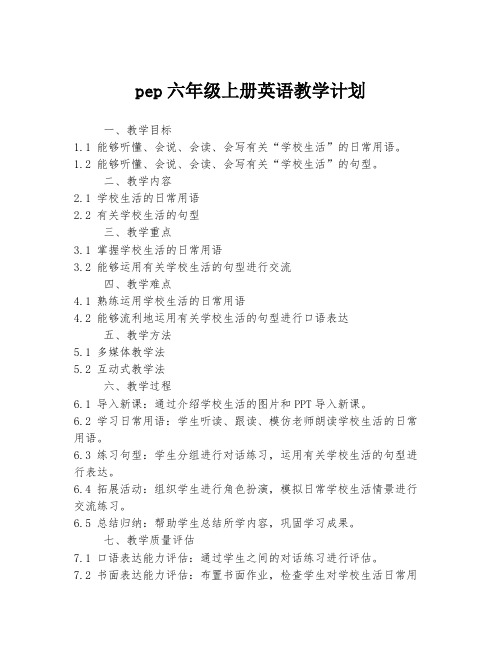
pep六年级上册英语教学计划
一、教学目标
1.1 能够听懂、会说、会读、会写有关“学校生活”的日常用语。
1.2 能够听懂、会说、会读、会写有关“学校生活”的句型。
二、教学内容
2.1 学校生活的日常用语
2.2 有关学校生活的句型
三、教学重点
3.1 掌握学校生活的日常用语
3.2 能够运用有关学校生活的句型进行交流
四、教学难点
4.1 熟练运用学校生活的日常用语
4.2 能够流利地运用有关学校生活的句型进行口语表达
五、教学方法
5.1 多媒体教学法
5.2 互动式教学法
六、教学过程
6.1 导入新课:通过介绍学校生活的图片和PPT导入新课。
6.2 学习日常用语:学生听读、跟读、模仿老师朗读学校生活的日常用语。
6.3 练习句型:学生分组进行对话练习,运用有关学校生活的句型进行表达。
6.4 拓展活动:组织学生进行角色扮演,模拟日常学校生活情景进行交流练习。
6.5 总结归纳:帮助学生总结所学内容,巩固学习成果。
七、教学质量评估
7.1 口语表达能力评估:通过学生之间的对话练习进行评估。
7.2 书面表达能力评估:布置书面作业,检查学生对学校生活日常用
语和句型的掌握情况。
八、教学反思
8.1 检查学生对学校生活日常用语的掌握情况,针对性加强练习。
8.2 鼓励学生多参与实际交流活动,提高口语表达能力。
2018-2019l六年级上学期英语教学计划
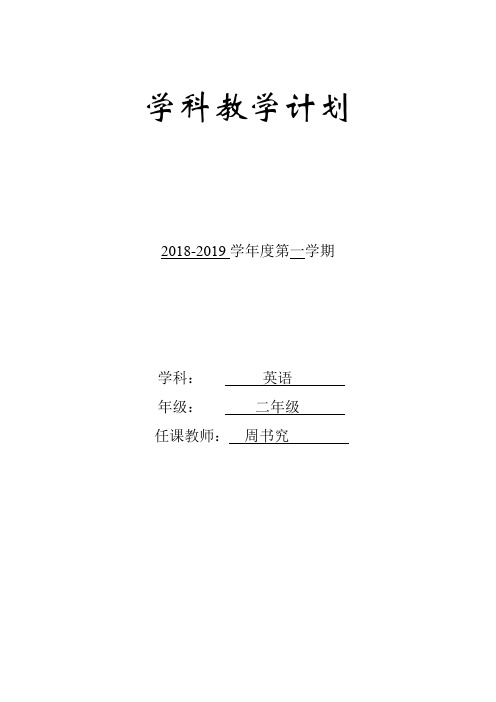
本册教材内容:
Unit 1 What did you do this summer? Unit 2 What happened to your neck? Unit 3 How did you go to Hangzhou ? Unit 5 When did the ancient Olympic Games begin? Unit 6 What is he wearing? Unit 7 What are the twelve animals?
教学目的要求:写出德育、知识能力(含创新精神和实践能力)等要求。
Unit 1 1.能讨论过去做的事,用准、用对一般过去时 what did you do last summer/when did you come back/did you do sth in the past.来提问。 2.能听懂、认读 went/had 等词的过去式,并能在相应情景中运用。 3.能读出含有字母 x 的单词,知道 x 在单词中的发音。 4.能理解本单元 listen and say 中的三个对话内容,并能朗读对话。 5.能读懂 now I can read 中的语段,并尝试复述。 6.能向 Mike 学习,增强关心老人、加强同学间交流,做到互相关心的意识。 Unit 2 1.能对身体健康状况进行询问和回答 。 2.能听懂、认读 hurt/cut 等词的过去式,并能在情景中运用。 3.能读出含有字母 y 的单词,知道 y 在单词中的不同发音及字母组合 ay/ey 的发音。 4.能理解本单元 Listen and say 中三个对话的内容,并能朗读对话。 5. 能读懂、理解 now I can read 中的语段,并尝试复述。 6.增强安全运动意识和自我保护意识,并能主动关心他人健康。
PEP小学六年级上册英语教学计划
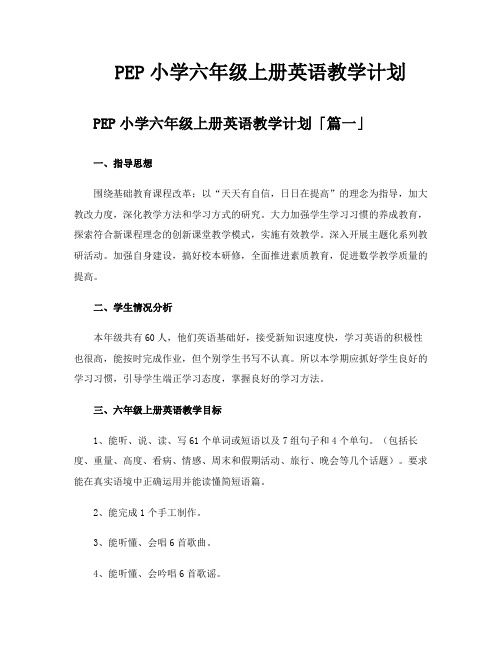
PEP小学六年级上册英语教学计划PEP小学六年级上册英语教学计划「篇一」一、指导思想围绕基础教育课程改革;以“天天有自信,日日在提高”的理念为指导,加大教改力度,深化教学方法和学习方式的研究。
大力加强学生学习习惯的养成教育,探索符合新课程理念的创新课堂教学模式,实施有效教学。
深入开展主题化系列教研活动。
加强自身建设,搞好校本研修,全面推进素质教育,促进数学教学质量的提高。
二、学生情况分析本年级共有60人,他们英语基础好,接受新知识速度快,学习英语的积极性也很高,能按时完成作业,但个别学生书写不认真。
所以本学期应抓好学生良好的学习习惯,引导学生端正学习态度,掌握良好的学习方法。
三、六年级上册英语教学目标1、能听、说、读、写61个单词或短语以及7组句子和4个单句。
(包括长度、重量、高度、看病、情感、周末和假期活动、旅行、晚会等几个话题)。
要求能在真实语境中正确运用并能读懂简短语篇。
2、能完成1个手工制作。
3、能听懂、会唱6首歌曲。
4、能听懂、会吟唱6首歌谣。
5、能完成4个自我评价活动。
6、能理解6个幽默小故事。
7、能了解6项简单的中西方文化知识。
四、六年级上册英语教材重难点1、能按四会、三会的要求掌握所学单词。
2、能按四会要求掌握所学句型。
3、能使用日常交际用语,活用四会句型,进行简单的交流,做到大胆开口,发音正确。
4、能在图片、手势、情境等非语言提示的帮助下,听懂清晰的话语和录音。
难点1、一般过去时、一般将来时等几个小学阶段所学句型中对人称、是动词的变化、行为动词的运用。
2、对四会要求掌握所学句型的灵活运用:对话、写作、阅读。
3、教学内容与学生的生活经验知识层次的有机结合。
五、六年级上册英语教学措施1、以活动为课堂教学的主要形式,设计丰富多彩的教学活动,让学生在乐中学、学中用,从而保证学生英语学习的可持续性发展。
2、通过听、说、读、写、唱、游、演、画、做等形式,进行大量的语言操练和练习。
3、培养学生拼读音标的能力,确保学生自主学习的质量。
2018-2019学年度第一学期小学英语教学计划
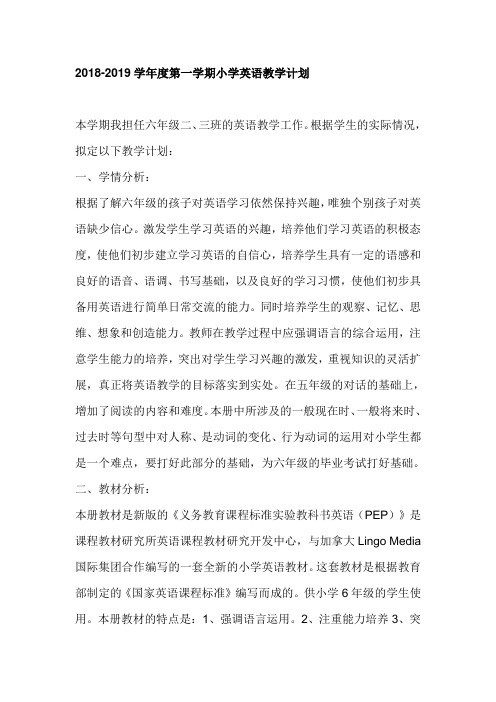
2018-2019学年度第一学期小学英语教学计划本学期我担任六年级二、三班的英语教学工作。
根据学生的实际情况,拟定以下教学计划:一、学情分析:根据了解六年级的孩子对英语学习依然保持兴趣,唯独个别孩子对英语缺少信心。
激发学生学习英语的兴趣,培养他们学习英语的积极态度,使他们初步建立学习英语的自信心,培养学生具有一定的语感和良好的语音、语调、书写基础,以及良好的学习习惯,使他们初步具备用英语进行简单日常交流的能力。
同时培养学生的观察、记忆、思维、想象和创造能力。
教师在教学过程中应强调语言的综合运用,注意学生能力的培养,突出对学生学习兴趣的激发,重视知识的灵活扩展,真正将英语教学的目标落实到实处。
在五年级的对话的基础上,增加了阅读的内容和难度。
本册中所涉及的一般现在时、一般将来时、过去时等句型中对人称、是动词的变化、行为动词的运用对小学生都是一个难点,要打好此部分的基础,为六年级的毕业考试打好基础。
二、教材分析:本册教材是新版的《义务教育课程标准实验教科书英语(PEP)》是课程教材研究所英语课程教材研究开发中心,与加拿大Lingo Media 国际集团合作编写的一套全新的小学英语教材。
这套教材是根据教育部制定的《国家英语课程标准》编写而成的。
供小学6年级的学生使用。
本册教材的特点是:1、强调语言运用。
2、注重能力培养3、突出兴趣激发4、重视双向交流5、融合学科内容6、重视灵活扩展7、实现整体设计。
三、教学目标:1、能听、说、读、写67个单词或短语以及35个句子。
(包括建筑,方位,交通工具,工作职位,周末和假期活动、旅行、等几个话题)。
要求能在真实语境中正确运用并能读懂简短语篇。
2、能完成1个手工制作。
3、能听懂、会唱6首歌曲。
4、能听懂、会吟唱6首歌谣。
5、能完成4个自我评价活动。
6、能理解6个幽默小故事。
7、能了解6项简单的中西方文化知识。
四.教学重难点:重点:1、能按四会、三会的要求掌握所学单词。
PEP小学六年级英语教学计划
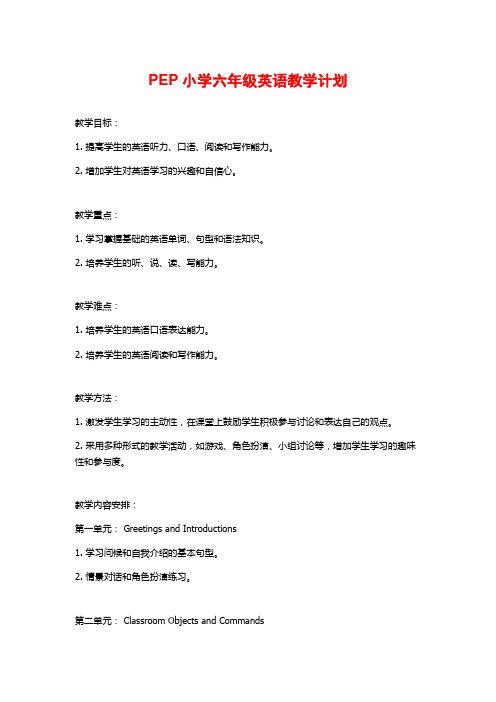
PEP小学六年级英语教学计划教学目标:1. 提高学生的英语听力、口语、阅读和写作能力。
2. 增加学生对英语学习的兴趣和自信心。
教学重点:1. 学习掌握基础的英语单词、句型和语法知识。
2. 培养学生的听、说、读、写能力。
教学难点:1. 培养学生的英语口语表达能力。
2. 培养学生的英语阅读和写作能力。
教学方法:1. 激发学生学习的主动性,在课堂上鼓励学生积极参与讨论和表达自己的观点。
2. 采用多种形式的教学活动,如游戏、角色扮演、小组讨论等,增加学生学习的趣味性和参与度。
教学内容安排:第一单元: Greetings and Introductions1. 学习问候和自我介绍的基本句型。
2. 情景对话和角色扮演练习。
第二单元: Classroom Objects and Commands1. 学习教室里常见物品的英文名称。
2. 学习常见的英语指令和命令句型。
3. 游戏活动:学生分小组,通过指令找出正确的物品。
第三单元: Numbers and Dates1. 学习基本的数字和日期表达方式。
2. 练习读和写基本的数字和日期。
第四单元: Weather and Seasons1. 学习天气和季节的英文表达方式。
2. 听音乐、看图片等活动,帮助学生感受不同季节和天气的变化。
第五单元: Daily Activities1. 学习日常活动的基本英文表达方式。
2. 角色扮演练习:学生分小组,模拟日常活动的情景对话。
第六单元: Food and Drinks1. 学习食物和饮品的英文表达方式。
2. 游戏活动:学生分小组,通过描述和猜测食物和饮品。
第七单元: Hobbies and Sports1. 学习爱好和运动的英文表达方式。
2. 小组讨论活动:学生分小组,介绍自己的爱好和运动。
第八单元: Festivals and Holidays1. 学习节日和假期的英文表达方式。
2. 角色扮演练习:学生分小组,模拟节日和假期的情景对话。
人教pep版2018-2019学年六年级上册英语全册教案
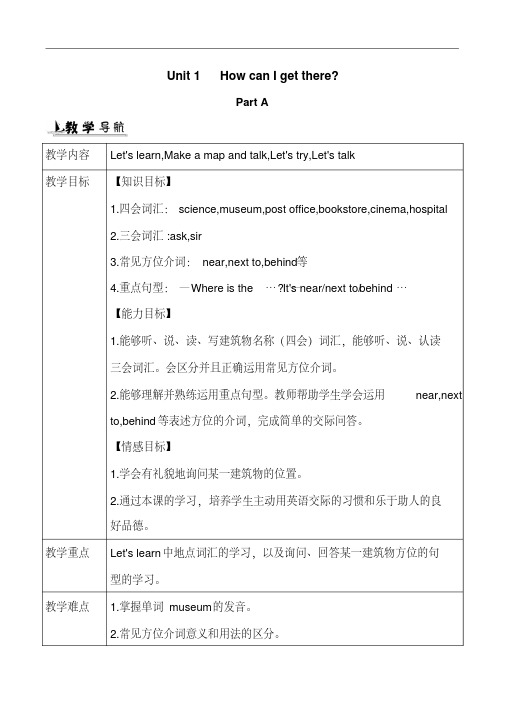
型的学习。
1.掌握单词 museum的发音。
2.常见方位介词意义和用法的区分。
教学准备
课件、录音机、 磁带(或其他音频播放设备) 、 课时安排 2 课时 一本书、教学图片若干、一张明信片、地图 等
第一课时
教学过程
批注
一、 Warm-up & Revision
师生自由问答。
“T”代 表
T:Good morning,everyone!
答案: post office,cinema,hospital,science museum,bookstore
Make a map and talk
教师告诉学生: “现在你们都是城市设计师,请大家设计一
张地图,设计好之后会有记者来采访。 ”让学生利用刚学的单词
对于场景
和词组设计城市规划图,并在班级里选几名学生充当小记者去
教学过程
批注
一、 Warm-up & Revision
这个环节
教师用课件或其他方式展示一系列小球与盒子的图片,小
复习了之前学
球分别处在盒子的不同方位。教师用图片带领学生复习句子:
过的知识 ——
“ Whereis the ball?It's in/on/behind the box. ”接 着展示一张公园 用方位介词描
Unit 1
How can I get there?
Part A
教学内容 教学目标
教学重点 教学难点
Let's learn,Make a map and talk,Let's try,Let's talk
【知识目标】
1.四会词汇: science,museum,post office,bookstore,cinema,hospital
pep六年级英语上册教学计划
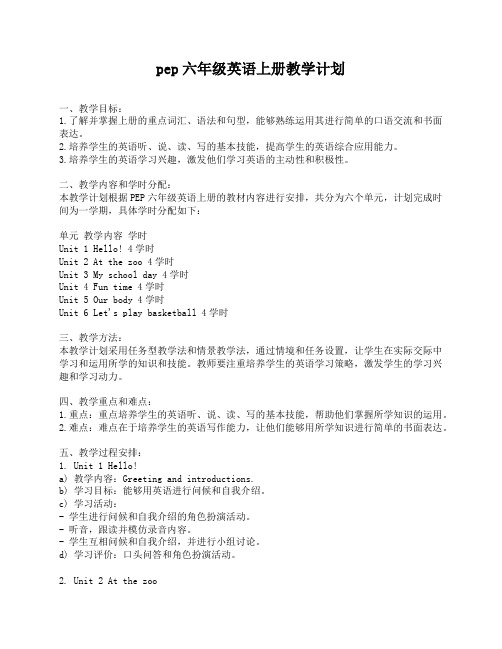
pep六年级英语上册教学计划一、教学目标:1.了解并掌握上册的重点词汇、语法和句型,能够熟练运用其进行简单的口语交流和书面表达。
2.培养学生的英语听、说、读、写的基本技能,提高学生的英语综合应用能力。
3.培养学生的英语学习兴趣,激发他们学习英语的主动性和积极性。
二、教学内容和学时分配:本教学计划根据PEP六年级英语上册的教材内容进行安排,共分为六个单元,计划完成时间为一学期,具体学时分配如下:单元教学内容学时Unit 1 Hello! 4学时Unit 2 At the zoo 4学时Unit 3 My school day 4学时Unit 4 Fun time 4学时Unit 5 Our body 4学时Unit 6 Let's play basketball 4学时三、教学方法:本教学计划采用任务型教学法和情景教学法,通过情境和任务设置,让学生在实际交际中学习和运用所学的知识和技能。
教师要注重培养学生的英语学习策略,激发学生的学习兴趣和学习动力。
四、教学重点和难点:1.重点:重点培养学生的英语听、说、读、写的基本技能,帮助他们掌握所学知识的运用。
2.难点:难点在于培养学生的英语写作能力,让他们能够用所学知识进行简单的书面表达。
五、教学过程安排:1. Unit 1 Hello!a) 教学内容:Greeting and introductions.b) 学习目标:能够用英语进行问候和自我介绍。
c) 学习活动:- 学生进行问候和自我介绍的角色扮演活动。
- 听音,跟读并模仿录音内容。
- 学生互相问候和自我介绍,并进行小组讨论。
d) 学习评价:口头问答和角色扮演活动。
2. Unit 2 At the zooa) 教学内容:Animals and descriptions.b) 学习目标:能够用英语进行动物的描述。
c) 学习活动:- 学生观看关于动物的视频,并进行听力练习。
- 学习并复习动物的名称,并进行分组游戏。
2018--2019学年度上学期六年级英语教学教研计划
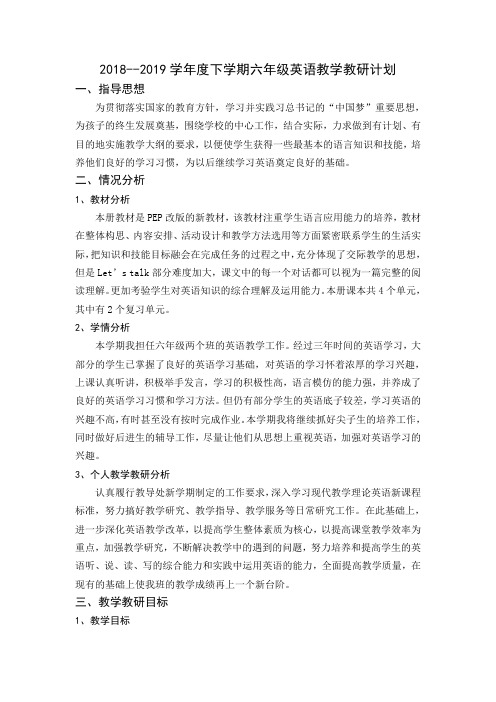
2018--2019学年度下学期六年级英语教学教研计划一、指导思想为贯彻落实国家的教育方针,学习并实践习总书记的“中国梦”重要思想,为孩子的终生发展奠基,围绕学校的中心工作,结合实际,力求做到有计划、有目的地实施教学大纲的要求,以便使学生获得一些最基本的语言知识和技能,培养他们良好的学习习惯,为以后继续学习英语奠定良好的基础。
二、情况分析1、教材分析本册教材是PEP改版的新教材,该教材注重学生语言应用能力的培养,教材在整体构思、内容安排、活动设计和教学方法选用等方面紧密联系学生的生活实际,把知识和技能目标融会在完成任务的过程之中,充分体现了交际教学的思想,但是Let’s talk部分难度加大,课文中的每一个对话都可以视为一篇完整的阅读理解。
更加考验学生对英语知识的综合理解及运用能力。
本册课本共4个单元,其中有2个复习单元。
2、学情分析本学期我担任六年级两个班的英语教学工作。
经过三年时间的英语学习,大部分的学生已掌握了良好的英语学习基础,对英语的学习怀着浓厚的学习兴趣,上课认真听讲,积极举手发言,学习的积极性高,语言模仿的能力强,并养成了良好的英语学习习惯和学习方法。
但仍有部分学生的英语底子较差,学习英语的兴趣不高,有时甚至没有按时完成作业。
本学期我将继续抓好尖子生的培养工作,同时做好后进生的辅导工作,尽量让他们从思想上重视英语,加强对英语学习的兴趣。
3、个人教学教研分析认真履行教导处新学期制定的工作要求,深入学习现代教学理论英语新课程标准,努力搞好教学研究、教学指导、教学服务等日常研究工作。
在此基础上,进一步深化英语教学改革,以提高学生整体素质为核心,以提高课堂教学效率为重点,加强教学研究,不断解决教学中的遇到的问题,努力培养和提高学生的英语听、说、读、写的综合能力和实践中运用英语的能力,全面提高教学质量,在现有的基础上使我班的教学成绩再上一个新台阶。
三、教学教研目标1、教学目标根据小学生的心理和生理特征以及发展需求,小学阶段的英语课程的目的是激发学生学习英语的兴趣,培养他们英语学习的积极态度,使他们建立初步的英语学习的自信心;培养学生一定的语感和良好语音、语调基础。
PEP人教版2018-2019学年小学六年级英语上册教学计划
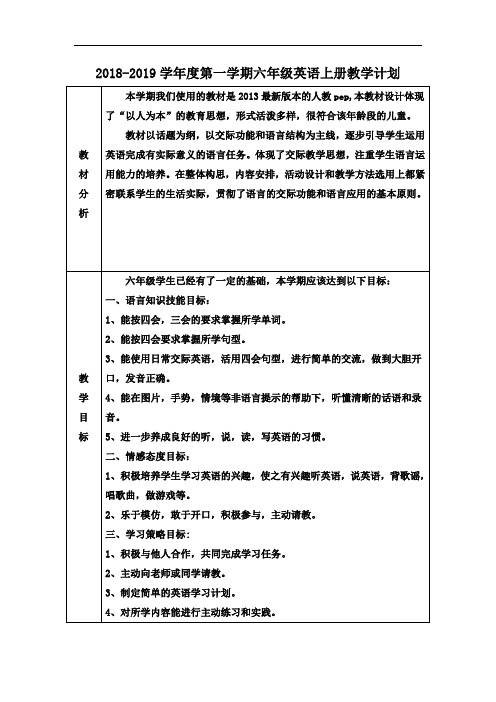
3、教学内容和学生的生活经验层次的有机结合。
教
学
措
施
1、以活动为课堂教学的主要形式,设计丰富多彩的教学活动,让学生在乐中学,学中用,从而保证学生英语学习的可持续性发展。
2、通过听,说,读,写,唱,游,演,画,做等形式进行大量的操练和练习。
3、培养学生拼读音标的能力,确保学生自主学习的质量。
4、设计全面高效的课外作业,培养学生良好的书写习惯,做到整洁,规范,正确的书写。
5、在教学过程中,采用情景教学法,让学生身临其境,积极主动的参与到课堂当中去,调动学生的非智力因素,提高学生实际运用语言的能力。
6、活用教材,根据学生的实际情况,将每单元各个板块进行整合,重组,降低难度。
教学进度表
周
次
教学内容
英语小短剧汇演
16-17
Unit5What does he do?
18-19
Unit 6 How do you feel?
20-21
Recycle 2
22-23
期终总复习
24
期终质量检测
2、情感态度目标:
1、积极培养学生学习英语的兴趣,使之有兴趣听英语,说英语,背歌谣,唱歌曲,做游戏等。
2、乐于模仿,敢于开口,积极参与,主动请教。
3、学习策略目标:
1、积极与他人合作,共同完成学习任务。
2、主动向老师或同学请教。
3、制定简单的英语学习计划。
4、对所学内容能进行主动练习和实践。
5、积极运用所学英语进行表达和交流。
教
学
重
点
难
点
教学重点:
1、能按四会,三会要求掌握所学单词和词汇。
2018-2019学年上、下期教学计划
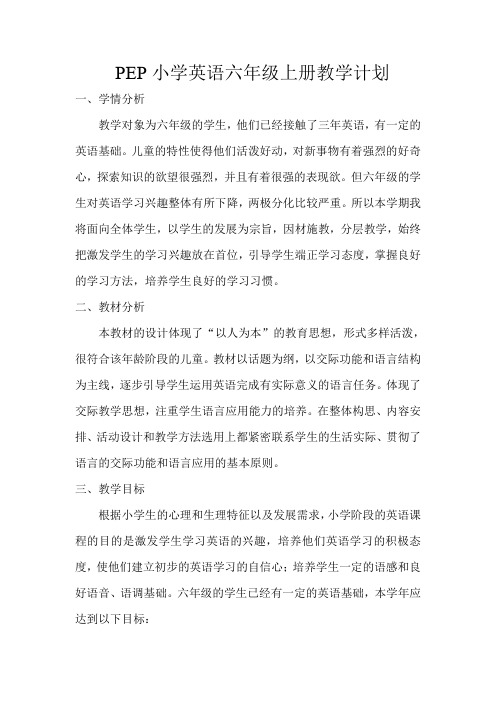
PEP小学英语六年级上册教学计划一、学情分析教学对象为六年级的学生,他们已经接触了三年英语,有一定的英语基础。
儿童的特性使得他们活泼好动,对新事物有着强烈的好奇心,探索知识的欲望很强烈,并且有着很强的表现欲。
但六年级的学生对英语学习兴趣整体有所下降,两极分化比较严重。
所以本学期我将面向全体学生,以学生的发展为宗旨,因材施教,分层教学,始终把激发学生的学习兴趣放在首位,引导学生端正学习态度,掌握良好的学习方法,培养学生良好的学习习惯。
二、教材分析本教材的设计体现了“以人为本”的教育思想,形式多样活泼,很符合该年龄阶段的儿童。
教材以话题为纲,以交际功能和语言结构为主线,逐步引导学生运用英语完成有实际意义的语言任务。
体现了交际教学思想,注重学生语言应用能力的培养。
在整体构思、内容安排、活动设计和教学方法选用上都紧密联系学生的生活实际、贯彻了语言的交际功能和语言应用的基本原则。
三、教学目标根据小学生的心理和生理特征以及发展需求,小学阶段的英语课程的目的是激发学生学习英语的兴趣,培养他们英语学习的积极态度,使他们建立初步的英语学习的自信心;培养学生一定的语感和良好语音、语调基础。
六年级的学生已经有一定的英语基础,本学年应达到以下目标:1、能按四会、三会的要求掌握所学单词。
2、能按四会要求掌握所学句型。
3、能使用日常交际用语,活用四会句型,进行简单的交流,做到大胆开口,发音正确。
4、能在图片、手势、情境等非语言提示的帮助下,听懂清晰的话语和录音。
5、进一步养成良好的书写习惯。
6、进一步养成听英语、读英语和说英语的良好习惯。
7、能运用相关的语言知识和技能,完成某项任务。
8、能演唱已学过的英语歌曲,诵读已学过的歌谣。
四、教材重点1、能按四会、三会的要求掌握所学单词。
2、能按四会要求掌握所学句型。
3、能使用日常交际用语,活用四会句型,进行简单的交流,做到大胆开口,发音正确。
4、能在图片、手势、情境等非语言提示的帮助下,听懂清晰的话语和录音。
PEP小学英语六年级上册教学计划
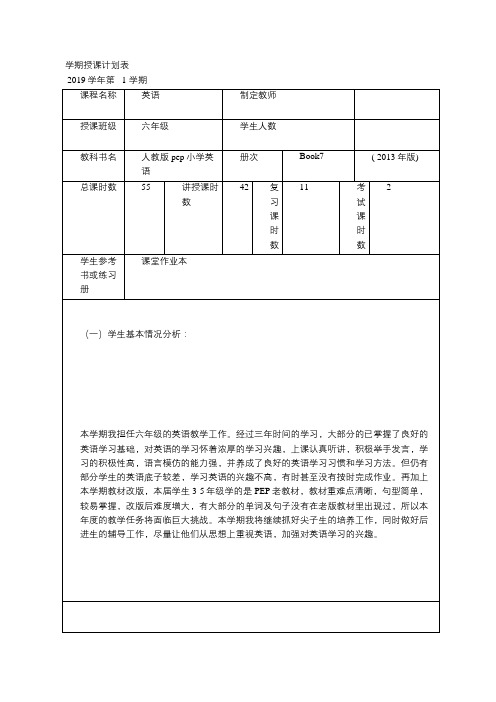
8.能了解6项简单的中西方文化知识。
(三)改进教学的具体措施:
1、校内外齐抓共管,家校结合,拓宽教育渠道。利用家长,让家长协助教师教育和督促自己的孩子努力学习。
2、课后多和后进生交谈,态度要和蔼,使后进生愿意接近老师,经常和老师说说心里话,有利于老师对学生了解,有利于做好后进生的转化工作。加强对后进生的个别心理辅导。深入学生的内心世界,搞好特别学生的情况跟踪调查,对其心理障碍进行研究和排除,矫治其心理疾病,充分发挥心理教育的德育功能。
5、优化课堂教学,分层次设计目标,给后进生制订能够完成的目标,使其能真正感到成功的喜悦。积极探索“低起点,多层次,高需求。”的课堂教学模式。“低起点”就是传授新知识的起始阶段放低起点,运用直观形象的方法,使学生听的懂,学得进。“多层次”就是针对学生的共性和个性差异,因材施教。“高要求”就是精心钻研教材,使所有的学生都处于“跳一跳,摘个桃”的学习状态。通过课堂教学改革,引导学生积极主动的学习与发展,从而全面提高教学质量。
文化的同时,也学会用英语向外国人介绍中华民族的优秀文化传统,真正实现跨文化交际。
1.能听、说、读、写71个单词和短语以及10组句子和7个单句。要求能在真实语境中正确运用并能读懂简短语篇。
2.能听、说、认读16个单词。
3.能完成1个手工制作。
4.能听懂、会唱8首歌曲。
5.能听懂、会吟唱8首歌谣。
6.能完成6个自我评价活动。
3、开展互帮互学的活动,座位的排列尽量让中、后进生创设一个好的学习环境,充分发挥课后“小老师”的作用。
4、对后进生的缺点批评要恰当得体,切忌不可伤害,不能让其他同学嘲笑他们,嫌弃他们。对后进生坚持“四个不”“五个先”原则。“四个不”即:不定性,不歧视,不溺爱,不加压。“五个先”即:表扬鼓励优先,关心帮助优先,作业批改和学习辅导优先,家访优先,参加群体活动优先,以努力提高教育的实效性。
2018-2019学年度六年级上学期英语教学计划
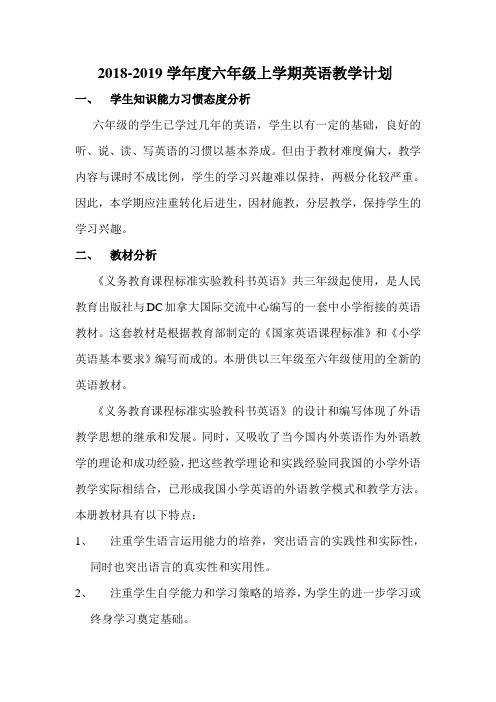
2018-2019学年度六年级上学期英语教学计划一、学生知识能力习惯态度分析六年级的学生已学过几年的英语,学生以有一定的基础,良好的听、说、读、写英语的习惯以基本养成。
但由于教材难度偏大,教学内容与课时不成比例,学生的学习兴趣难以保持,两极分化较严重。
因此,本学期应注重转化后进生,因材施教,分层教学,保持学生的学习兴趣。
二、教材分析《义务教育课程标准实验教科书英语》共三年级起使用,是人民教育出版社与DC加拿大国际交流中心编写的一套中小学衔接的英语教材。
这套教材是根据教育部制定的《国家英语课程标准》和《小学英语基本要求》编写而成的。
本册供以三年级至六年级使用的全新的英语教材。
《义务教育课程标准实验教科书英语》的设计和编写体现了外语教学思想的继承和发展。
同时,又吸收了当今国内外英语作为外语教学的理论和成功经验,把这些教学理论和实践经验同我国的小学外语教学实际相结合,已形成我国小学英语的外语教学模式和教学方法。
本册教材具有以下特点:1、注重学生语言运用能力的培养,突出语言的实践性和实际性,同时也突出语言的真实性和实用性。
2、注重学生自学能力和学习策略的培养,为学生的进一步学习或终身学习奠定基础。
3、注重教材的灵活性和可操作性,以满足不同层次的学生的需求。
4、注重教学资料的配套,为学生提供良好的英语学习环境,帮助学生拓展自我发展的空间。
三、教学目的的任务1、养成良好的听英语、读英语、说英语的习惯。
2、初步养成良好的书写习惯。
3、能按三会与四会的要求掌握所学词语和句型。
4、能运用所学的日常交际用语进行简单的日常交流,并做到大胆开口,积极参与,发音清楚,语调正确。
5、能在图片、手势、情景等非语言提示的帮助下,听懂简单的话语和录音材料。
6、能在任务性学习的过程中运用相关的语言知识和技能,完成某项任务。
7、能演唱已学的英语歌曲,能诵读已学过的英语歌谣。
四、教学重点难点1、重点:①四会句型、单词②运用所学的日常交际用语进行简单的日常交流,并做到大胆开口,积极参与,发音清楚,语调正确。
XX小学第一学期六年级(3)班英语学科(上册)教学计划
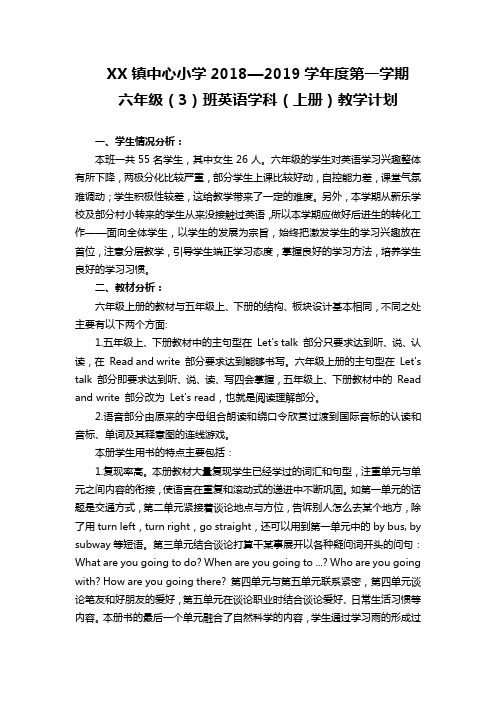
XX镇中心小学2018—2019学年度第一学期六年级(3)班英语学科(上册)教学计划一、学生情况分析:本班一共55名学生,其中女生26人。
六年级的学生对英语学习兴趣整体有所下降,两极分化比较严重,部分学生上课比较好动,自控能力差,课堂气氛难调动;学生积极性较差,这给教学带来了一定的难度。
另外,本学期从新乐学校及部分村小转来的学生从来没接触过英语,所以本学期应做好后进生的转化工作——面向全体学生,以学生的发展为宗旨,始终把激发学生的学习兴趣放在首位,注意分层教学,引导学生端正学习态度,掌握良好的学习方法,培养学生良好的学习习惯。
二、教材分析:六年级上册的教材与五年级上、下册的结构、板块设计基本相同,不同之处主要有以下两个方面:1.五年级上、下册教材中的主句型在Let's talk 部分只要求达到听、说、认读,在Read and write 部分要求达到能够书写。
六年级上册的主句型在Let's talk 部分即要求达到听、说、读、写四会掌握,五年级上、下册教材中的Read and write 部分改为Let's read,也就是阅读理解部分。
2.语音部分由原来的字母组合朗读和绕口令欣赏过渡到国际音标的认读和音标、单词及其释意图的连线游戏。
本册学生用书的特点主要包括:1.复现率高。
本册教材大量复现学生已经学过的词汇和句型,注重单元与单元之间内容的衔接,使语言在重复和滚动式的递进中不断巩固。
如第一单元的话题是交通方式,第二单元紧接着谈论地点与方位,告诉别人怎么去某个地方,除了用turn left,turn right,go straight,还可以用到第一单元中的by bus, by subway等短语。
第三单元结合谈论打算干某事展开以各种疑问词开头的问句:What are you going to do? When are you going to ...? Who are you going with? How are you going there? 第四单元与第五单元联系紧密,第四单元谈论笔友和好朋友的爱好,第五单元在谈论职业时结合谈论爱好、日常生活习惯等内容。
- 1、下载文档前请自行甄别文档内容的完整性,平台不提供额外的编辑、内容补充、找答案等附加服务。
- 2、"仅部分预览"的文档,不可在线预览部分如存在完整性等问题,可反馈申请退款(可完整预览的文档不适用该条件!)。
- 3、如文档侵犯您的权益,请联系客服反馈,我们会尽快为您处理(人工客服工作时间:9:00-18:30)。
2018-2019学年六年级(上)英语教学计划一.学情分析六年级学生已经接触了五年英语,有一定的英语基础。
他们活泼好动,对新事物有着强烈的好奇心,探索知识的欲望很强烈,并且有着很强的表现欲。
但六年级的学生对英语学习兴趣整体有所下降,两极分化比较严重。
所以本学期我将面向全体学生,以学生的发展为宗旨,因材施教,分层教学,始终把激发学生的学习兴趣放在首位,引导学生端正学习态度,掌握良好的学习方法,培养学生良好的学习习惯。
二.教材分析本教材的设计体现了“以人为本”的教育思想,形式多样活泼,很符合该年龄阶段的儿童。
教材以话题为纲,以交际功能和语言结构为主线,逐步引导学生运用英语完成有实际意义的语言任务。
体现了交际教学思想,注重学生语言应用能力的培养。
在整体构思、内容安排、活动设计和教学方法选用上都紧密联系学生的生活实际、贯彻了语言的交际功能和语言应用的基本原则。
三.学期教学目标根据小学生的心理和生理特征以及发展需求,小学阶段的英语课程的目的是激发学生学习英语的兴趣,培养他们英语学习的积极态度,使他们建立初步的英语学习的自信心;培养学生一定的语感和良好语音、语调基础。
六年级的学生已经有一定的英语基础,本学年应达到以下目标:1、掌握所学单词。
2、掌握所学句型。
3、能使用日常交际用语,进行简单的交流,做到大胆开口,发音正确。
4、能在图片、手势、情境等非语言提示的帮助下,听懂清晰的话语和录音。
5、进一步养成良好的书写习惯。
6、进一步养成听英语、读英语和说英语的良好习惯。
7、能运用相关的语言知识和技能,完成某项任务。
8、能演唱已学过的英语歌曲,诵读已学过的歌谣。
四.教材重点和难点1、掌握所学单词。
2、掌握所学句型。
3、能使用日常交际用语,进行简单的交流,做到大胆开口,发音正确。
4、能在图片、手势、情境等非语言提示的帮助下,听懂清晰的话语和录音。
五.单元教学目标Unit1 How do you go there?1、能力目标(1)能够正确询问并回答乘坐某种交通工具去某地, 如: How do you go to school? Usually I go to school by bike. Sometimes I go on foot. How can I get to Zhongshan Park? You can go by the No. 15 bus.(2)能够描述人们日常出行的方式,并简单陈述理由, 如: Usually I go to school by subway, because it’s fast.(3)能够辨认一些常见的交通标志,了解并遵守交通规则,特别是要学会看交通指示灯安全地过去马路。
(4)能够了解一同国家交通规则的异同。
2、知识目标(1)掌握A,B部分let’s learn, let’s talk中的四会短语和句子。
(2)能够听,说,认读A, B部分的let’s learn三会单词和let’s talk, let’s read中出现的三会句型。
(3)能够理解并会根据指令操作let’s play, let’s chant, group work等部分的内容。
(4)了解音标/i:/, /i/, /p/, /b/, /t/, /d/的音和形,能够区分音标/i:/和/i/ 发音不同。
(5)能够了解Story time, Good to know, Task time等部分的内容。
3、情感、策略、文化等有关目标(1)通过了解交通规则,认识交通标志,学会在生活中自觉遵守交通规则。
(2)培养学生乐于助人的情感,让他们具有一定的团结合作、竞争进取的品格素质。
Unit 2 Where is the science museum?1、能力目标(1)简单描述城市、城镇或区内公共设施的大致位置,如:“Where is the cinema, please? It’s next to the hospital.”等。
(2)能够询问路线并简单回答,如:Where is the post office? It’s east of the cinema. Turn left at the cinema, then go straight. It’s on the left.(3)能够了解地图的基本标识,并能用东、西、南、北简单表示行政区划的位置。
(4)能够听懂、会唱歌“Where are you going?”2、知识目标(1)能够掌握A、B部分Let’s learn和Let’s talk中的四会单词和句子。
(2)能够听、说、认读A、B部分Let’s learn的三会单词和Let’s talk,Let’s read.中的三中的三会句子。
(3)能够理解、会唱Let’s chant, Let’s sing等部分的内容。
(4)能够了解Pronunciation中音标/e/, /a/, /k/, /g/, /f/, /v/, /s/, /z/的音与形并能正确读了例词。
(5)能够了解Story time, Good to know, Task time等部分的内容。
3、情感、策略、文化等有关目标(1)情感态度:培养学生团结友爱、乐于助人的良好品质。
使学生愿意在小组活动中积极与他人合作,互相帮助,共同完成学习任务。
(2)学习策略:引导学生在学习过程中注重合作学习,利用课本中设计的Pair work, Group work, Let’s play以及Task time部分,培养学生合作学习的意识。
(3)文化目标:简单了解国外地图的主要标识。
Unit 3 What are you going to do?1、能力目标(1)能够用be going to句型交流行事计划, 如:.What are you going to do this evening? I am going to the cinema.等。
(2)能够用where, when替换句型:What are you going to do? 中的疑问词what 提问并回答, 如:Where are you going? I am going to the bookstore. When are you going? I am going at 3 o’clock.等。
(3)能够了解他人的行事计划并进行转述, 如: He /She is going to…等。
2、知识目标(1)能够掌握A, B 部分let’s learn, let’s talk中的四会单词和句子。
(2)能够听, 说, 认读A, B 部分let learn, let talk和let read中的三会掌握单词和句子。
(3)能够了解pronunciation部分音标的音和形, 并完成相应练习。
(4)能够理解并会唱let’s chant部分的歌谣;能够听懂、会唱歌曲“What are you going to do? ”。
(5)了解story time, good to know等部分的内容。
3、情感、策略、文化等有关目标(1)培养学生合理安排自己学习和生活,能按计划、有条理地做事情的能力;(2)培养学生具有一定的团结合作竞争进取的优良品格。
Recycle 11、能力目标(1)综合运用1-3单元的主要语言进行有实际意义的交流。
(2)能够根据Let’s find out部分的指示语找到地图中的相应位置并写出场所词。
(3)能够运用be going to do句型在Group work中讨论自己的梦想之旅。
(4)能够听懂Listen and match与Listen and choose部分的对话并完成相应的练习。
(5)能够听懂、会唱歌“How can I get to the zoo?”2、知识目标(1)能够听、说、认读两篇Let’s read的对话,并完成文后的正误判断题。
(2)能够理解并会吟唱Let’s chant的歌谣。
(3)能够认读1-3单元Pronunciation部分的音标并能把音标与单词正确连线。
3、情感、策略、文化等有关目标(1)情感态度:培养学生的团结友爱意识。
(2)学习策略:引导学生独立思考、解决问题。
Unit 4 I have a pen pal1、能力目标(1)能够询问和简单描述业余爱好,如:What’s your hobby? I like collecting stamps. He likes collecting stamps, too.(2)能够用一般疑问句形式询问他人的住处,工作等情况并作答,如:Does he live in the city? Yes, he does. Does he teach English? No, he doesn’t. He teaches art.(3)能够听懂、会唱歌曲“My pen pal”。
2、知识目标(1)能够掌握A、B部分Let’s learn,Let’s talk中的四会单词和四会句子。
(2)能够听、说、认读A、B部分Let’s talk,Let’s read中的白体句子。
(3)能够认读Pronunciation部分的音标:/з:/, /э/, /∫/, /З/, /l/, /r/并能读出例词。
(4)能够理解Let’s chant部分的内容。
(5)能够了解Story time, Good to know, Task time等部分的内容。
3、情感、策略、文化等有关目标:(1)情感态度:鼓励学生发展广泛的兴趣与爱好,培养学生乐于与人交往的性格。
(2)学习策略:积极运用所学语言进行表达与交流,加强合作,共同完成学习任务。
(3)文化目标:了解一些英语书信的基本知识。
Unit 5 What does she do?1、能力目标(1)能够简单介绍人物职业,如:She is a cleaner.(2)能够运用句型“What does your mother do? Where does she work? How does she go to work?”等询问他人的工作情况,并能给出相应回答。
2、知识目标(1)能够掌握A,B部分let’s learn , let’s talk中的四会单词和句子。
(2)能够听,说,认读A,B部分let’s talk, let’s learn中的白体句子。
(3)了解元音/u:/, /u/和辅音/ w/, /j/, /h/等的发音并读出例词。
(4)能够了解Story time, Good to know, Task time等部分的内容。
3、情感、策略、文化等有关目标(1)热爱生活,尊重他人的劳动。
(2)能够与他人合作,共同完成学习任务。
(3)了解英语中职业名称对于不同性别的差异。
